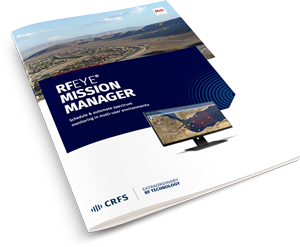CRFS demonstrates multi-layer geolocation capabilities of RFeye

CRFS, the Cambridge-based developer of RFeye spectrum intelligence systems, has deployed a distributed network of RFeye receivers across the city to demonstrate its latest transmitter geolocation capabilities. CRFS has implemented a multi-layer approach to geolocation that greatly increases the probability of identifying and pinpointing unauthorised transmissions and suspicious targets, thereby speeding up the ability to respond to potential threats.
In modern society there are many different threats that may have a wireless communications component. Learning to recognise such threats and being able to act on them should be an important part of any public safety or national security strategy. Also, as the number of wireless devices grows exponentially and spectrum becomes increasingly congested, spectrum regulators need to be able to quickly identify and locate any sources of interference.
CRFS has an important role to play in all of these areas. Networks of RFeye receivers are used to detect rogue and malicious transmitters such as GPS jammers that may threaten the normal operation of the GPS-based systems on which we all rely: - transport infrastructure, emergency response services, financial systems, etc. They are used to help secure sensitive buildings, critical installations or borders against security threats including unauthorised entry and covert listening devices. They can “sweep” public buildings or sports arenas to check for suspicious signals or patterns that may indicate potential criminal or terrorist activity. Spectrum regulators deploy RFeye to create national inventories of spectrum usage, identify bottlenecks and find sources of interference.
CRFS’s new approach overlays the results of various geolocation techniques onto a map in real time, thereby greatly increasing the probability of pinpointing the source of transmissions of all kinds. These techniques are AOA (Angle of Arrival), TDOA (Time Difference of Arrival) and POA (Power on Arrival), each of which has performance characteristics suited to particular signal and transmission types.
CEO, Alistair Massarella explains: “There is no one size fits all for locating different types of transmitters in different environments. There are many factors that impact the chances of finding the source. The power of the signal, the distance from the receivers, the terrain, whether it’s in-building or in open space, these all play a role. Our philosophy is that since you don’t know in advance what you are looking for, you need to be prepared. AOA is great for finding signals of any modulation type, TDOA works well for lower power signals over larger areas, POA is good in-building - so you need to be able to apply any or all of these techniques, as appropriate. And by combining and overlaying them, you have a much better chance of finding what you are looking for.”
CRFS is currently in discussion with a number of leading system integrators about creating wide area RFeye networks using its latest multi-layer geolocation techniques. The RFeye receivers can be deployed as fixed mast mounted units, in-vehicle mobile units or as man-portable StormCase or BackPack versions. CRFS is able to provide live demonstrations of the Cambridge network over IP to interested parties.
ENDS
Watch the webinar
HOW TO RECORD AND EXTRACT SIGNALS FROM BIG RF DATA
Watch the webinar to learn how to improve your RF data recording process and unleash the full potential of your spectrum monitoring system.

GET INSTANT NEWS UPDATES
Subscribe to the CRFS blog to recieve RF news, straight to your inbbox